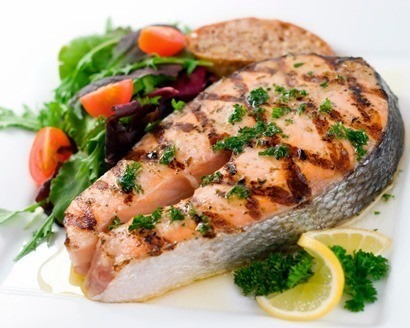Salmon From Alaska's Copper River — The Best
Though some examples of farmed salmon are better than others, in general it doesn't compare very well to its wild-caught cousin at all. Because the farmed variety is pretty much ubiquitous today — it outnumbers wild salmon in the marketplace by a factor of more than three to one — it has become a cliché, a dependable fish, cheap and inoffensive enough to serve on airplanes, in school cafeterias, and at what used to be known as rubber-chicken banquets but could now very well be called mushy-salmon feasts.
 There is no salmon farmed in Alaska. It isn't permitted. And the state's wild salmon is as good as it gets, in all its varieties — most notably the noble king (sometimes called chinook), meaty and complex, but also the red-fleshed sockeye with its faint shellfish flavor, and the milder coho. The richest Alaskan salmon, of all types, comes from the Copper River, a 300-mile-long torrent that drains the Wrangell and Chugach mountain regions in the central portion of the state. Because the salmon in this sustainably managed fishery must travel long distances upstream (the ascent is more than 1,000 feet) against a strong current to reach their spawning grounds, they develop higher-than-usual stores of omega-3 fatty acids, which make their flesh not only healthier to consume but richer in body and flavor than that of salmon from most other places. That it is harvested by gill-netting from small boats and iced as it's caught, with minimum handling, adds to its appeal.
There is no salmon farmed in Alaska. It isn't permitted. And the state's wild salmon is as good as it gets, in all its varieties — most notably the noble king (sometimes called chinook), meaty and complex, but also the red-fleshed sockeye with its faint shellfish flavor, and the milder coho. The richest Alaskan salmon, of all types, comes from the Copper River, a 300-mile-long torrent that drains the Wrangell and Chugach mountain regions in the central portion of the state. Because the salmon in this sustainably managed fishery must travel long distances upstream (the ascent is more than 1,000 feet) against a strong current to reach their spawning grounds, they develop higher-than-usual stores of omega-3 fatty acids, which make their flesh not only healthier to consume but richer in body and flavor than that of salmon from most other places. That it is harvested by gill-netting from small boats and iced as it's caught, with minimum handling, adds to its appeal.
Click here to see Eric Ripert's Seared Salmon Recipe.
The arrival of Copper River king salmon in the marketplace each year — its short season spans just mid-May through June — is a major event at seafood restaurants and fish markets in the Pacific Northwest. It may be as good as salmon gets — firm, almost buttery, with an intense, mouth-filling salmon flavor. Sockeye, which tastes equally salmony but with crustacean overtones and a bit less richness, is the most readily available variety of Copper River salmon because its season runs through September. Coho, harvested in August and September, is lighter in color and milder in flavor than king or sockeye, but very high in omega-3s — and from the Copper River, even coho has a lot more character than farmed salmon of other varieties. Much Copper River salmon is sold frozen, incidentally, and though it is a fish that freezes well, the fresh version has better texture and more vivid flavor.
 Good seafood restaurants around the country showcase Copper River salmon when it arrives. To make finding it easier, the seafood trade association SeafoodSource.com is launching a Facebook app allowing consumers to search for markets and restaurants near them that carry the fish, or to share Copper River sources they may have discovered with others. The app, at www.findcopperriver.org, will go live around May 15.
Good seafood restaurants around the country showcase Copper River salmon when it arrives. To make finding it easier, the seafood trade association SeafoodSource.com is launching a Facebook app allowing consumers to search for markets and restaurants near them that carry the fish, or to share Copper River sources they may have discovered with others. The app, at www.findcopperriver.org, will go live around May 15.
Click here to see Bobby Flay's Chile-Honey-Glazed Salmon Recipe.
